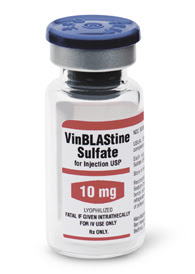
Vinblastine is a chemotherapy medication, typically used with other medications, to treat a number of types of cancer. This includes Hodgkin's lymphoma, non-small cell lung cancer, bladder cancer, brain cancer, melanoma, and testicular cancer. More
Vinblastine is a chemotherapy medication, typically used with other medications, to treat a number of types of cancer. This includes Hodgkin's lymphoma, non-small cell lung cancer, bladder cancer, brain cancer, melanoma, and testicular cancer.
Vinblastine
Vinblastine; Vincaleukoblastine; Velban; Vincaleucoblastine
Cytoblastin, Uniblastin, Vblastin
methyl (1R,9R,10S,11R,12R,19R)-11-(acetyloxy)-12-ethyl-4-[(13S,15R,17S)-17-ethyl-17-hydroxy-13-(methoxycarbonyl)-1,11-diazatetracyclo[13.3.1.0?,¹².0?,¹?]nonadeca-4(12),5,7,9-tetraen-13-yl]-10-hydroxy-5-methoxy-8-methyl-8,1
Hepatic metabolism.
Vinblastine is a vinca alkaloid antineoplastic agent. The vinca alkaloids are structurally similar compounds comprised of 2 multiringed units: vindoline and catharanthine. Vinblastine has some immunosuppressant effect. The vinca alkaloids are considered to be cell cycle phase-specific.
The recommended dose is 3.7 mg/m2 as IV, dose may be increased if needed.
For treatment of lymphomas, breast cancer, neuroblastoma, testicular cancer, Hodgkin's and non-Hodgkin's lymphomas, mycosis fungoides, histiocytosis, and Kaposi's sarcoma.
Alopecia, constipation, malaise, stomatitis, GI bleeds, dose-limiting bone marrow suppression (e.g. granulocytopenia, thrombocytopenia, anaemia), hypertension, central and peripheral neurotoxicity, vomiting, 8th cranial nerve damage resulting in vestibular and auditory toxicity, ischaemic cardiac toxicity, breathlessness, bone, tumour or jaw pain, nausea, necrosis.
Store at 2-8°C
810.9741
C46H58N4O9
865-21-4